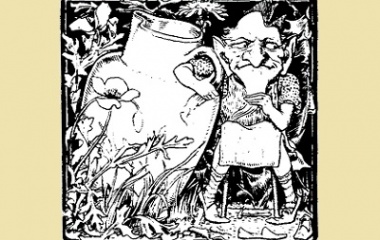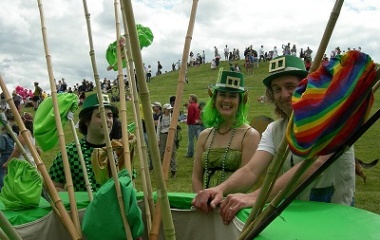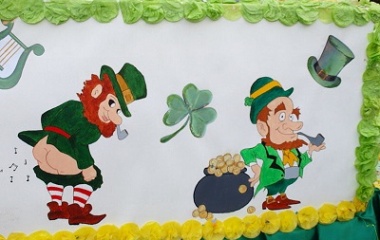Wandering the emerald hills of Ireland, you might hear a faint tap tap tap coming from beneath your feet. This is the sound of a Leprechaun hard at work, but don’t bother searching for him. These elusive little men are almost impossible to find, and the consequences of finding them aren’t always good!
What is a Leprechaun?
A Leprechaun is a small fairy or elf, hailing from the green shores of Ireland. These little creatures work hard and play even harder. They are delicate craftsmen, with nimble fingers ideal for shoe-making, and many of them have amassed a fortune from this art. When they leave their secret, underground cobbler benches for a jaunt through the human world, they leave a trail of mischief—and sometimes enchanted gold—behind them.
Characteristics
Physical Description
The Leprechaun’s sense of style has been tweaked here and there during centuries of fame, but his overall appearance has remained remarkably true to tradition. He is a small man, two to three feet tall, with a wrinkled face and a fluffy beard. His eyes have a roguish twinkle, and he is perfectly nimble, no matter how ancient his wrinkles might make him seem.
Leprechauns love to look dapper when they go outside. They wear old-fashioned coats, each one perfectly tailored to the little person who wears it. The cut of the coat can vary from region to region, as well as the embellishments, which range from golden military trim to seven rows of seven buttons. Every Leprechaun wears a hat, although the styles range from top hats to jockey caps to little cones without a brim, and they all have exquisite shoes with tiny shining buckles.
In early accounts, the Leprechaun is said to dress in red, a color which symbolizes lone fairies. In the twentieth century, the wee folk began to appear in green, probably because that color was strongly associated with their homeland.
Personality
Leprechauns aren’t overly friendly creatures, but they aren’t mean-hearted either. While they are notorious tricksters, they rarely lash out at innocent people. Instead, they save their pranks for people who have tried to trap them or take advantage of them.
Above all else, Leprechauns are intelligent. They know how greedy men can be, so they hide themselves and their treasure in underground burrows, with the entrances concealed so that they look like a rabbit’s hole or a hollow tree. If you do happen to catch one of these elusive little men above ground, you must be careful how you talk to him. Leprechauns are masters of deception. They can find a loophole in any deal they make with you, and they can twist your dearest wishes into a nightmare.
Although they are certainly shrewd, Leprechauns don’t sit around brooding and plotting all day. They much prefer merrymaking to revenge-seeking, and they spend a great deal of time playing music and dancing with other fairies. In fact, many Irish people believe that these wee folk became shoemakers because they were constantly dancing their shoes to shreds!
Many people today believe that the little men are drunkards who guzzle huge amounts of Irish whiskey and ale at their dances. This is an incorrect belief that springs from stereotypes about Irish people in general, rather than from folk tales about Leprechauns themselves.
Special Abilities
Like all of Ireland’s “little people,” Leprechauns are full of magic. They can cast all sorts of small enchantments, but they choose to use most of their magic in an endless game of hide-and-go-seek, which they play with humans. They can appear out of thin air and vanish into thin air. They can conjure up mesmerizing images, like pots of gold at the end of a rainbow, that entrance humans into wandering aimlessly around the countryside. If you catch them, they can grant you three wishes—but they usually find a way to make sure one of those wishes backfires.
Aside from their magical abilities, Leprechauns are extremely skilled in several arts. Their talent at shoemaking is, of course, unparalleled, but they are also gifted musicians. They can play enchanting songs on all of the traditional Irish instruments, from the stout Bhodran drum to the delicate Irish harp.
Cultural Representation
Origin
Leprechauns are reputed to be members of the Tuath de Danann, a tribe of merry, magical beings who roamed the Emerald Isle long before human civilization left its cradle.
According to folklore, the Tuath de Danann were driven underground as human civilization blossomed. Historically, it’s clear that these early Gaelic gods were, in a sense, “banished” by the Christian church; scholarly monks explained them away as ancient kings, queens, and heroes whose legend had grown to unrealistic proportions, and church administrators banned worship of the Tuath de Danann. Still, a stronghold of believers continued to record stories about Ireland’s original magical rulers, and so their legend survived.
Literature
Leprechaun-like characters first appear in Medieval accounts of the Tuath de Dananna, like The Book of Linster and Echtra Fergus mac Léti.Their popularity exploded during the nineteenth century, when romantic poets like William Butler Yeats and Irish nationalist poets like David Russel McAnally and William Allingham adopted them as the darlings of Irish folklore.
Since the turn of the twentieth century, Leprechauns have popped up in several popular fantasy novels, including the Harry Potter series and the Artemis Fowl series, and they are featured in almost every encyclopedia of fairies and folklore that exists.
Tourism and Controversy
Even though Leprechauns were once beloved by the Irish people, many Irishmen today could do without mention of these green-garbed, gold-grubbing little men. The wee folk have become a catch-all for unflattering stereotypes about the Irish people, and many Irish people view them as misrepresentations of their country and culture—especially when they see all the Leprechaun keychains, chocolate gold coins, and ridiculous hats piling up in tourist shops.










